Depression Statistics – By Industry, Demographic, Country, The Economic Impact
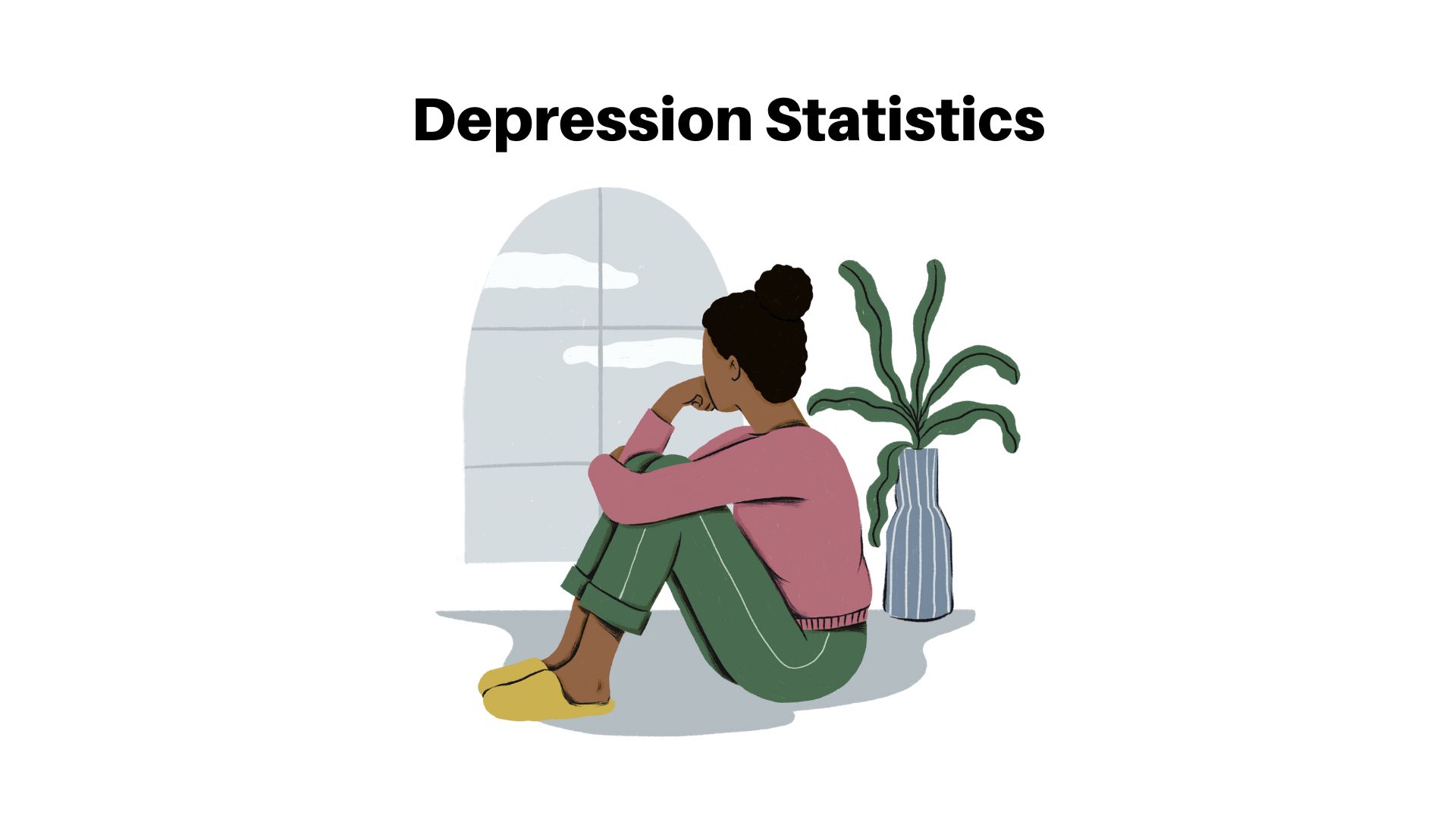
Page Contents
- Introduction
- Editor’s Choice
- What is depression?
- Types of depression
- Symptoms of depression
- Causes of depression
- How to fight against depression?
- General Depression Statistics
- Depression Statistics By Industry
- Depression Statistics by demographic
- By Gender
- By Age
- by Major Depressive Episodes (Reference: Statista.com) As of 2021, Depression Statistics in the United States of America recorded that 6.2% of the male population and 10.3% female population suffer from depressive episodes. Out of these 8.3% of both genders were 18 years lesser. Furthermore, 18.6% of the population was from the 18 years to 25 years of age group, and 9.3% belonged to the 26 years to 49 years of demographic group. There were around 4.5% of the population who were 50 years old or more. By Health
- By Income Level
- By Location
- By Education
- By Insurance Coverage
- Depression Statistics By Country
- By Highest
- By Lowest
- Depression Statistics By The Economic Impact
- How depression affects differently to Women Vs Men?
- Conclusion
Introduction
Depression Statistics: Depression is the most common cause of suicides around the world. Depression is a silent killer which can slowly damage the lifestyle of a person. Just by looking at the person we can’t tell if that individual is suffering from depression or not. Today, there are many cases when one day before that person was enjoying his life by partying, and the next day we hear him dead by suicide. Therefore, a lesson must be learned that, if a person is silent, we need to hear him/her out before something bad happens.
These Depression statistics represent insights from around the globe with the unfortunate numbers recorded by various segments.
Editor’s Choice
- According to Depression statistics, in the United States of America, more than 17 million adults are struggling with the problem.
- Some women may experience depression before and during the menstrual cycle.
- In the United States of America, on average, 6 million suffer from depression but out of these only 10% get medical help.
- Around the world, more than 300 million people are suffering from depression as of 2023.
- Moreover, the depression rate is 1.5 to 3 times more common in women than men.
- In the younger generation, no treatment for depression is a primary reason for suicide.
- The rate of depression among patients with chronic diseases is 2 to 3%.
- Depression is the leading cause that can impact severely on country’s economy.
- Around the globe, further Depression statistics state that there are 10% of patients with severe depression, 20% with moderate depression, and 70% of cases belonging to mild depression.
- Global rates of depression are continuously rising.
What is depression?
Depression is the state of mind and a mixture of mood swings that occur in any individual during any sad or unhappy or stressed event. A high level of depression is treatable by medications, but if ignored it may lead to unfortunate suicide and death. It is required to talk to such persons feeling low in their life, and it is okay to talk about Depression subjects. Following are some types of depression observed on a mild or critical level but yet curable at many times.
Types of depression
- Atypical depression – increased appetite, increased sleeping cycle, feeling of heavy legs and arms, extra sensitive to criticism.
- Premenstrual dysphoric disorder – anxiety, trouble while concentrating, fatigue, change in sleeping or eating habits, mood swings, and irritability.
- Situational depression – for e.g., in the events of divorce, death in the family, or losing the job.
- Psychotic depression – delusions, paranoia, and hallucinations.
- Postpartum depression – experienced after childbirth.
- Seasonal affective disorder – experienced mostly in winter months which goes away in summer or spring.
- Persistent Depressive disorder – Low self-esteem, feeling hopeless, increased sleeping time, trouble while making decisions, lack of energy.
Symptoms of depression
- Increased digestive problems, headaches, and body pains.
- Withdrawal symptoms from socialization.
- Negative thoughts such as suicide, death, and suicide attempts.
- Lack of energetic body as well as mind.
- Struggling to sleep.
- Continuous feelings of irritation from simple activities.
- Change in the eating cycle.
- Difficulty remembering, concentrating, talking, or making decisions.
- The feeling of being worthless to others.
- Slowed body moments.
- Decreased self-confidence.
- Loss of interest in hobbies.
Causes of depression
- Depression can occur from recurring conflicts between family members or friends.
- People who are older at the age have a high level of depression rate.
- Living alone, isolation from everyone.
- Negative thoughts, living with negative people.
- Monthly hormonal changes in the women.
- Long-term chronic diseases.
- Continued medications.
- Death or loss of a dear person.
- Abuse, sexual harassment.
- Genes
- Big life events, for e.g., losing a job, getting divorced, etc.…
- Serious illness.
- Excessive drug or alcohol use.
How to fight against depression?
- Set your future goals.
- Don’t think too much.
- Eat healthy food.
- Stay away from alcoholic drugs.
- Introduce meditation, and exercise into your lifestyle.
- Circle yourself with good and positive people.
- Develop your personality and take up some responsibilities.
- Control your mind.
- Change the daily routine and bad habits.
- Read and write freely.
- Regularly, attend fun activities.
- And if necessary, visit doctors and follow their routine.
General Depression Statistics
- In England, depression has caused a loss of 109 million working days among patients.
- The rate of depression among patients with chronic diseases is 2 to 3%.
- According to Depression statistics, around 300 million people are suffering from depression as of 2023.
- Around the globe, further Depression statistics state that there are 10% of patients with severe depression, 20% with moderate depression, and 70% of cases belonging to mild depression.
- 1 out of 8 adolescents suffers from major depression.
- In the United States of America, on average, 6 million suffer from depression but out of these only 10% get medical help.
- In the younger generation, no treatment for depression is a primary reason for suicide.
- 1 out of 33 children struggles with depression.
- 1 out of 4 cancer patients suffer from depression symptoms.
- People who have an eating disorder also suffer from these symptoms resulting in 50% to 75%.
- Some women may experience depression before and during the menstrual cycle.
- Less than 50% get treated for their depression problems.
- Only 1 out of 5 people receive consistent medical help.
- Global rates of depression are continuously rising.
- According to Depression statistics, in the United States of America, more than 17 million adults are struggling with the problem.
Depression Statistics By Industry
 (Reference: MentalHelp.net)
(Reference: MentalHelp.net)
- The industry in which employees face the highest rate of depression is public and private transportation resulting in 16.2%.
- The second and third largest industries with the highest depression rates are real estate and social services with 15.7% and 14.6% respectively.
- Other ranked industries with similar depression rates are manufacturing and production and personal service by 14.3%.
- Legal services and environmental administration and waste services contribute to the depression rate by 13.4% whereas organization and association administration has 13.3%.
- 6% and 12.4% depression rates are carried by the industry of security and commodity brokers and print and publishing.
Depression Statistics by demographic
By Gender
- After divorce, women are more likely hit by depression than men.
- 7% of women and 5.3% of men suffer from depression.
- Moreover, the depression rate is 1.5 to 3 times more common in women than men.
By Age
- Children aged between 5 to 19 years have a 2.1% of depression rate.
- 7% of adults 60 years and above experience depression.
- 90% of children as well as young people recover within the first year of depression.
- On a global level, 5% of adults experience depression symptoms.
by Major Depressive Episodes
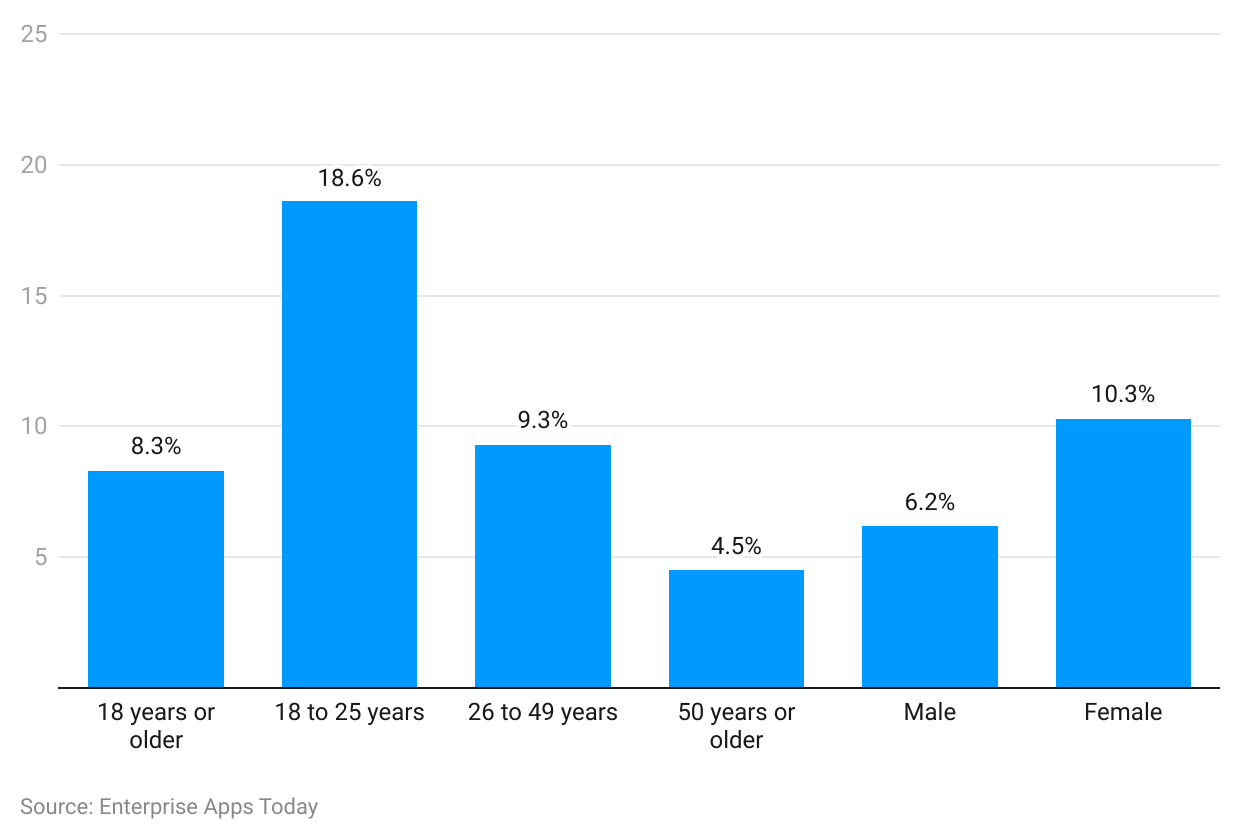 (Reference: Statista.com)
(Reference: Statista.com)
- As of 2021, Depression Statistics in the United States of America recorded that 6.2% of the male population and 10.3% female population suffer from depressive episodes.
- Out of these 8.3% of both genders were 18 years lesser.
- Furthermore, 18.6% of the population was from the 18 years to 25 years of age group, and 9.3% belonged to the 26 years to 49 years of demographic group.
- There were around 4.5% of the population who were 50 years old or more.
By Health
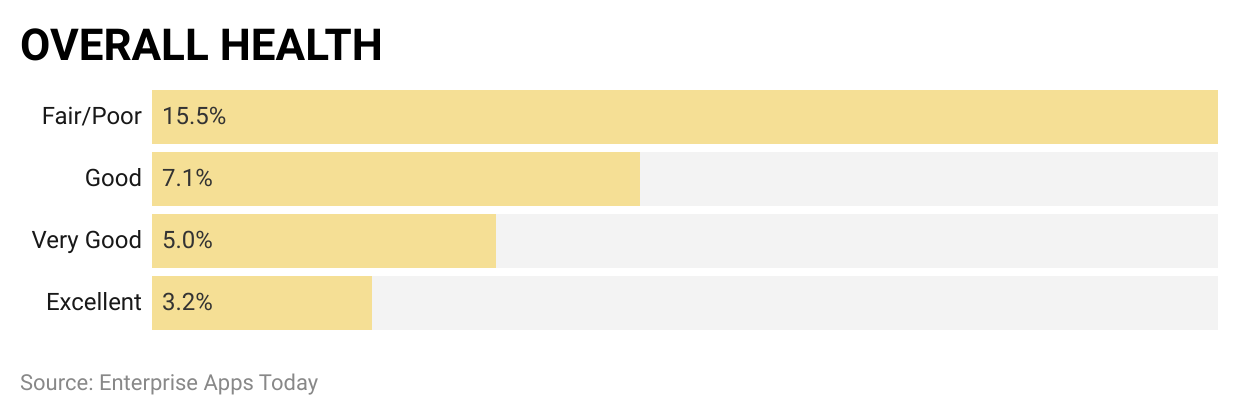 (Reference: MentalHelp.net)
(Reference: MentalHelp.net)
- Considering the lifestyle and health of a particular family, Depression statistics say that those who have a low level of lifestyle have 15.5% of depression problems.
- 1% and 5% of the families with good and very good lifestyles also suffer from depression issues.
- There are only 3.2% of the cases from excellent family lifestyle background fighting with depression.
By Income Level
 (Reference: MentalHelp.net)
(Reference: MentalHelp.net)
- There are 10.4% of people suffer from depression who are below the poverty level as stated by Depression Statistics.
- There are around 7.5% and 5.4% of people who struggle with depression who are at or just above the poverty level and much more above the poverty level accordingly.
By Location
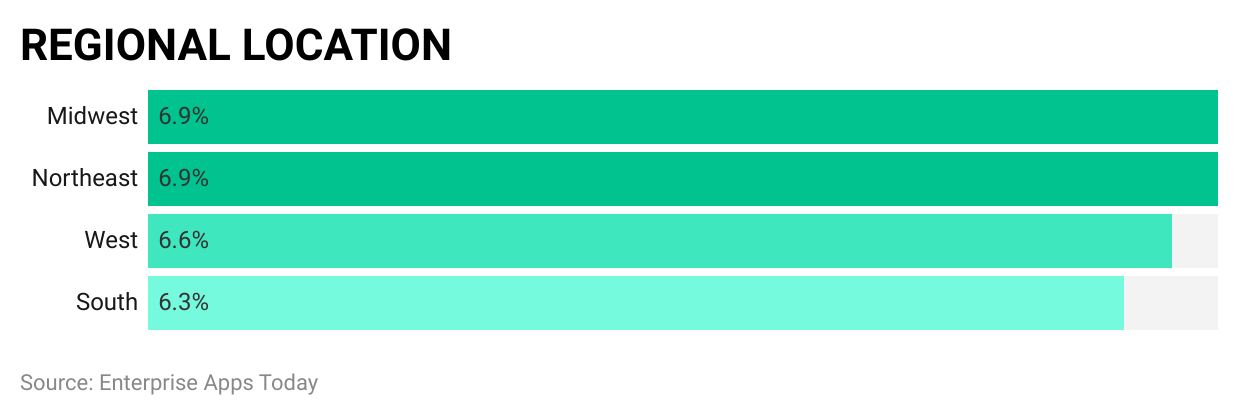
 (Reference: MentalHelp.net)
(Reference: MentalHelp.net)
Regional Location
- As per the Depression statistics, the highest number of the population lives in Midwest and Northeast with a similar percentage of 6.9%.
- 6% and 6.3% of people struggling with depression live in the West and South areas.
By location type
- Similarly, the highest number of the population living in the rural area resulted at 7.2%.
- Small and Large metro areas have 6.9% and 6.3% populations with depression issues situated respectively.
By Education
 (Reference: MentalHelp.net)
(Reference: MentalHelp.net)
- Depression Statistics say that 7.6% of people who have college-level knowledge are suffering from depression.
- There are 7.1% high school level education population and 6.5% of the people are high school graduates.
- Similarly, 5.5% of the people who have a college-level degree suffer from depression.
By Insurance Coverage
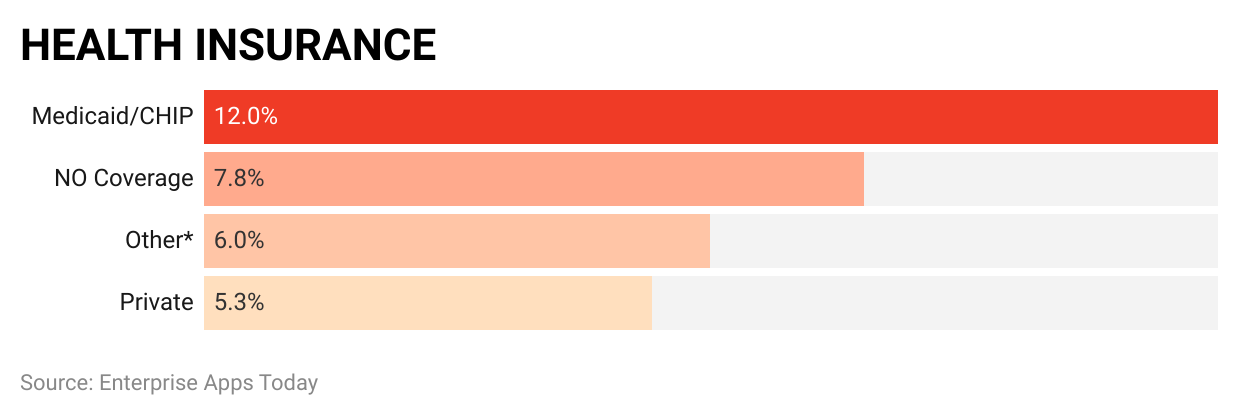 (Reference: MentalHelp.net)
(Reference: MentalHelp.net)
- There is 12% of the population with Medicaid/ CHIP insurance facility, who are suffering from Depression.
- Other people with no coverage and various types of insurance are around 7.8% and 6% respectively.
- People with private insurance policies contribute to the depression statistics by 5.3%.
Depression Statistics By Country
By Highest
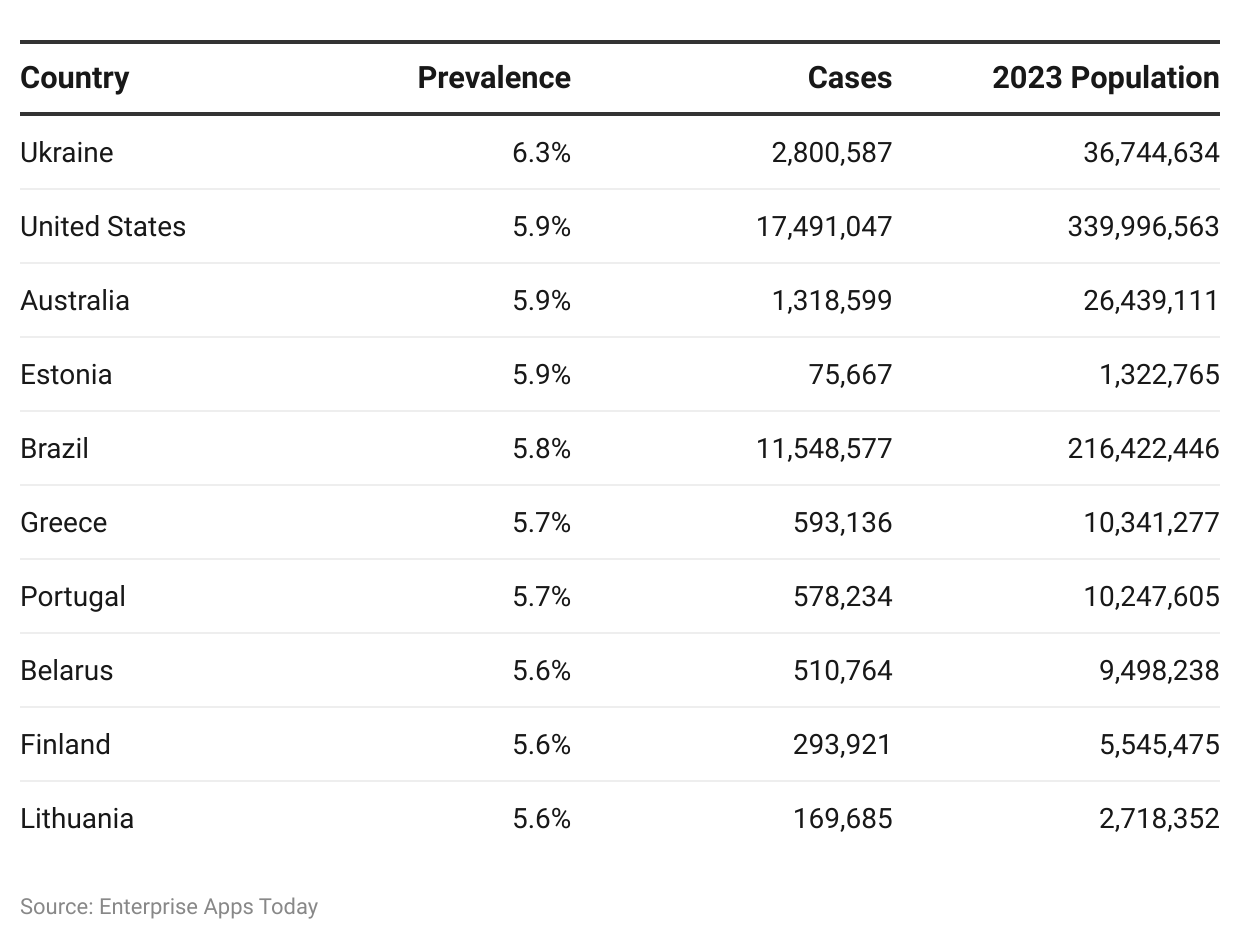 (Reference: worldpopulationreview.com)
(Reference: worldpopulationreview.com)
- As of 2023, Depression Statistics Ukraine has the highest rate of cases resulting in 6.3% with 2,800,587 out of 36,744,634 population.
- The United States of America, and Australia shares the same percentage of total depression cases by 5.9%, with 17,491,047 and 1,318,599 out of 339,996,563 and 26,439,111 respectively.
- Other countries with the highest number of depression cases per population are Australia 5.9% (1,318,599 / 26,439,111), Estonia 5.9% (75,667/ 1,322,765), Brazil 5.8% (11,548,577 / 216,422,446), Greece 5.7% (593,136 / 10,341,277), Portugal 5.7% (578,234 / 10,247,605), Belarus 5.6% (510,764 / 9,498,238), Finland 5.6% (293,921 / 5,545,475) and Lithuania 5.6% (169,685 / 2,718,352).
By Lowest
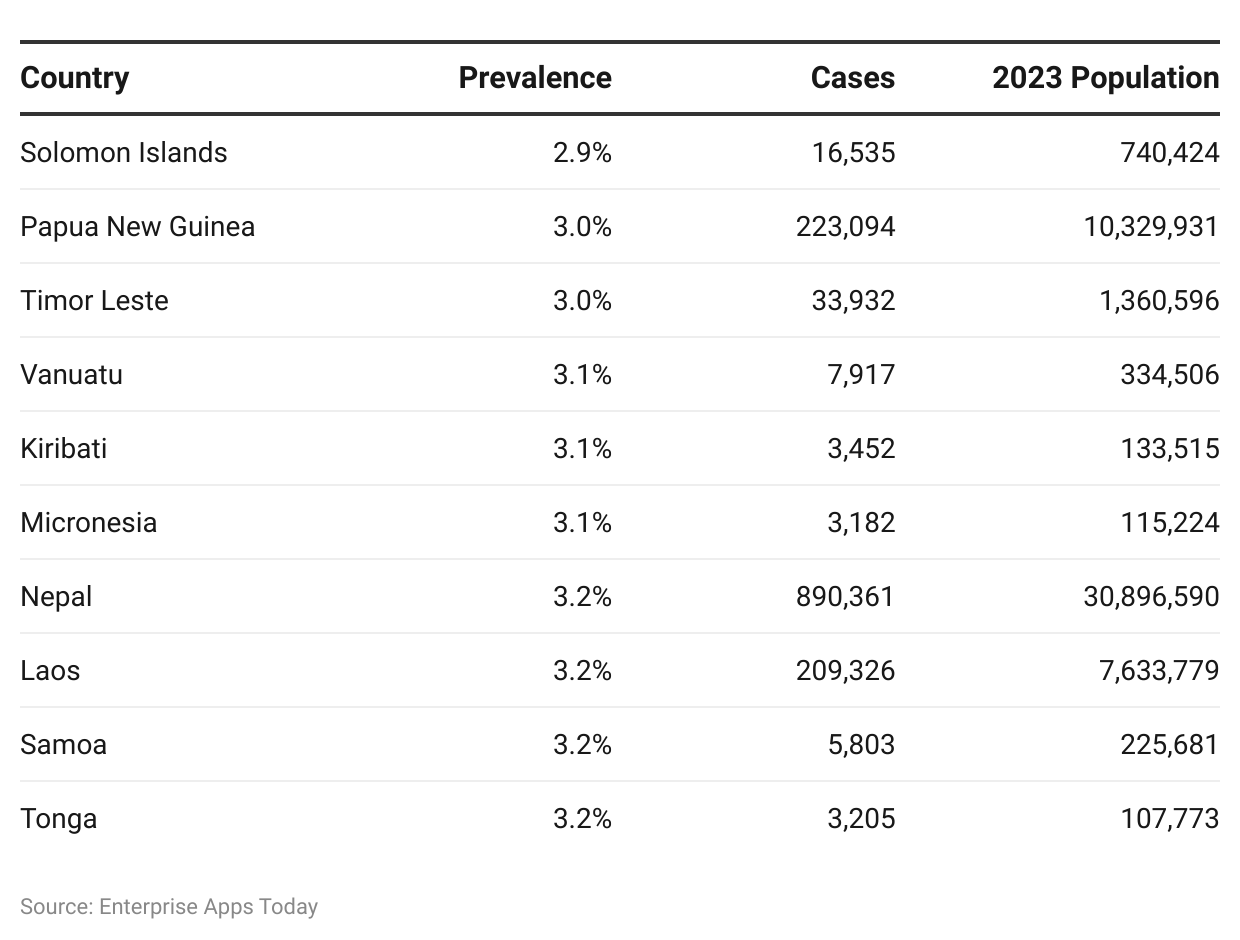 (Reference: worldpopulationreview.com)
(Reference: worldpopulationreview.com)
- As per the Depression Statistics 2023, the Solomon Islands has the lowest rate of depression cases resulting in 16,535 as compared to 740,424.
- Furthermore, Papua New Guinea and Timor Leste share the same percentage at 3%, with cases of 223,094 and 33,932 out of 10,329,931 and 1,360,596 respectively.
- Additionally, countries with minor differences in the percentage are Kiribati 3.1% (3,452 / 133,515), Micronesia 3.1% (3,182 / 115,224), Nepal 3.2%, (890,361/ 30,896,590), Laos 3.2% (209,326 / 7,633,779), Samoa 3.2% (5,803 / 225681), And Tonga 3.2% (3,205/ 107,773).
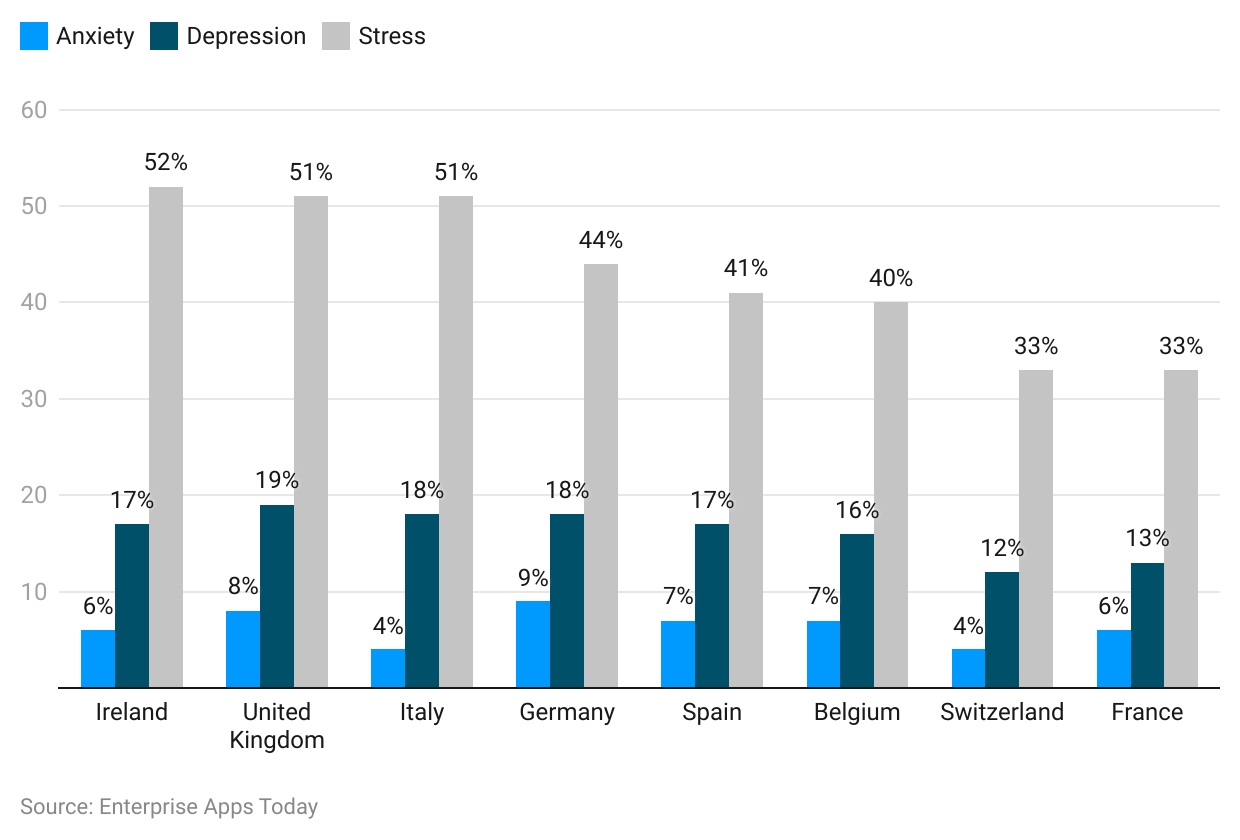 (Reference: Statista.com)
(Reference: Statista.com)
- As of 2022, in Europe, Ireland has the most population suffering from various mental health problems. 6% of the population has Anxiety, 17% are struggling with depression, and 52% of the population is fighting with stress.
- Other countries with the following numbers are facing similar issues: the United Kingdom: Anxiety (8%), Depression (19%), Stress (51%), Italy: Anxiety (4%), Depression (18%), Stress (51%), Germany: Anxiety (9%), Depression (18%), Stress (44%), Spain: Anxiety (7%), Depression (17%), Stress (41%), Belgium: Anxiety (7%), Depression (16%), Stress (40%), Switzerland: Anxiety (4%), Depression (12%), Stress (33%), and France: Anxiety (6%), Depression (13%), Stress (33%).
- On average, Stress is a common factor disturbing mental health in Europe followed by Depression and Anxiety.
Depression Statistics By The Economic Impact
- Depression is the leading cause that can impact severely on country’s economy.
- 48% to 50% of the economic cost goes to absences from workplaces along with decreased productivity.
- Furthermore, 45% to 47% of the economic cost is allotted to the treatment of outpatient and inpatient depression.
How depression affects differently to Women Vs Men?
Factors
Women
Men
Health issues
Fluctuating hormones affected the menstrual cycle
–
Emotional symptoms
Worthlessness, Mood swings, guilt
Anger, restlessness, irritability
Physical symptoms
Breast tenderness, heartaches, extreme weakness
Chest tightness, heart palpitations, low testosterone, erectile dysfunction, digestive issues.
Behavioral symptoms
Decreased appetite, suicide attempts, crying for no reason.
Completed suicide, risky behavior, extreme drinking habits, and increased drug use.
(Reference: Brainsway.com)
Conclusion
These Depression statistics taught us some important insights from various sectors which need to be improved. Depression is common but timely treatment is important for such a problem. Depression can occur from any unwanted situation, but it is a must to have a strong and focused mind so that such events never hamper your mind. If you know someone with depression, don’t ignore him/her. Talk to them and help to save a life.
Sources
FAQ.
How to prevent depression?
You can prevent depression by talking to friends or family members you trust, sharing your problems, taking a visit to a doctor, and doing some fun activities.
Can you recover from depression?
Of course, you can recover from depression. You just have to adopt some positive changes in life and if it is severe take medications and have a strong willpower, then your depression will be cured.
I always feel low, and my lifestyle has changed, it is depression?
It’s okay to feel low sometimes. Not all bad days are going to stick forever. But even if you are well settled and have no problems in life, and yet you have continuous low feelings, then you must visit a doctor as soon as possible.
How to treat depression?
Depression can be treated by psychotherapy, light therapy, and various prescribed medications. Although, it depends on the level of depression the person is suffering from.
 Ketaki Joshi
Ketaki Joshi
By conducting scientific research, I write about illness, health and healthcare. As a professional medical writer, my experience includes creating feature articles for newsletters and websites as well as research news stories for doctors and researchers. Reading has been an integral part of me since childhood - I'm fan of "Friends" and the "Harry Potter series".
Before this career, I was employed by a French multinational company. However, my passion for reading led me to pursue writing professionally; my first Amazon-published short story entitled "The envelope that changed our lives" has recently been released. In my free moments, I enjoy long bike rides around town.
Read next
 (Reference: Statista.com)
(Reference: Statista.com) (Reference: MentalHelp.net)
(Reference: MentalHelp.net) (Reference: MentalHelp.net)
(Reference: MentalHelp.net)
 (Reference: MentalHelp.net)
(Reference: MentalHelp.net) (Reference: MentalHelp.net)
(Reference: MentalHelp.net) (Reference: MentalHelp.net)
(Reference: MentalHelp.net) (Reference: worldpopulationreview.com)
(Reference: worldpopulationreview.com) (Reference: worldpopulationreview.com)
(Reference: worldpopulationreview.com) (Reference: Statista.com)
(Reference: Statista.com)Sources
FAQ.
You can prevent depression by talking to friends or family members you trust, sharing your problems, taking a visit to a doctor, and doing some fun activities.
Of course, you can recover from depression. You just have to adopt some positive changes in life and if it is severe take medications and have a strong willpower, then your depression will be cured.
It’s okay to feel low sometimes. Not all bad days are going to stick forever. But even if you are well settled and have no problems in life, and yet you have continuous low feelings, then you must visit a doctor as soon as possible.
Depression can be treated by psychotherapy, light therapy, and various prescribed medications. Although, it depends on the level of depression the person is suffering from.

By conducting scientific research, I write about illness, health and healthcare. As a professional medical writer, my experience includes creating feature articles for newsletters and websites as well as research news stories for doctors and researchers. Reading has been an integral part of me since childhood - I'm fan of "Friends" and the "Harry Potter series". Before this career, I was employed by a French multinational company. However, my passion for reading led me to pursue writing professionally; my first Amazon-published short story entitled "The envelope that changed our lives" has recently been released. In my free moments, I enjoy long bike rides around town.